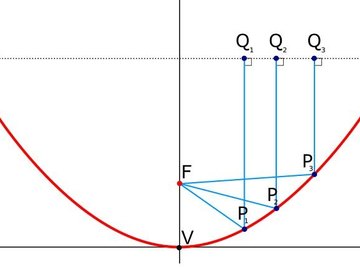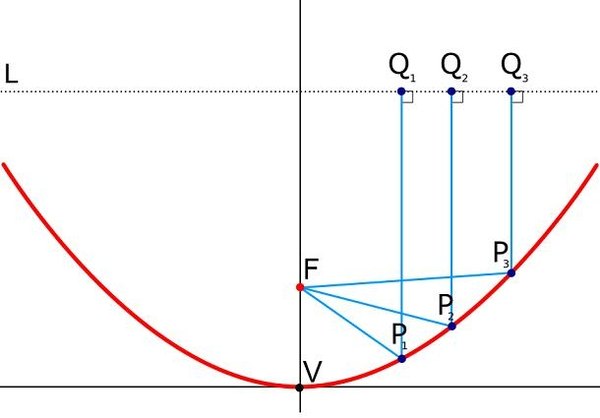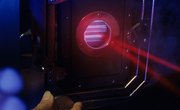
What Is A Parabola?

A parabola is a geometric curve with a fascinating property: when a line (Q) hits the inner surface at any point (P), the slope at that point will reflect the line into a single location, the "focus" of the parabola (F). Therefore, if an infinite number of parallel lines hit the parabola straight on, every single one of them would be reflected into the focus.
How Can A Parabolic Disk Amplify Sound?
When you make sound, such as talking, that sound is carried through the air in a sound wave. Sound waves spread out around you in an ever-expanding and ever-weakening circle. However, no matter what direction its traveling in, a given sound wave carries the same auditory information in it. When sound waves hit a rigid, dense surface, they can reflect off of it in another direction. This reflecting of sound waves causes such phenomena as echoes and reverberation.
If a distant sound wave hits a rigid disk, it will reflect off of the point of impact according to the angle of the surface. However, with a parabolic disk, we know that the sound waves will reflect toward a very specific location: the focus. If a faint sound wave hits the disk at hundreds of different points, these sound waves will all be reflected toward the focus. The sound wave contains the same data at all points, this refocusing of the wave will result in a uniform, amplified signal.
How A Parabolic Microphone Works

While the sound is amplified at the focus, the user cannot simply place his ear there as the rest of his head would block the sound waves. Instead, a parabolic microphone places a small audio receiver at the focus by attaching it to the end of a long plastic arm. The audio receiver connects via wire to an amplifier circuit which plugs into a set of ear phones worn by the user.
To operate the parabolic microphone, the user simply spies his target from far off and aims the dish directly at it. However, due to the distance, even a slight turn of the device could throw it a few feet off course. As such, the user must constantly use his own listening skills as a guide to ensure that the microphone is properly locked on the target.
References
About the Author
A Chicago-based copywriter, Andy Pasquesi has extensive experience writing for automotive (BMW, MINI Cooper, Harley-Davidson), financial services (Ivy Funds, William Blair, T. Rowe Price, CME Group), healthcare (Abbott) and consumer goods (Sony, Motorola, Knoll) clients. He holds a Bachelor of Arts in English from Harvard University but does not care for the Oxford comma.
